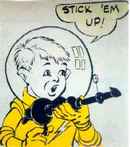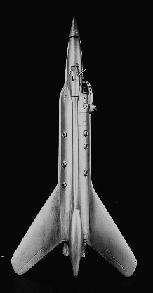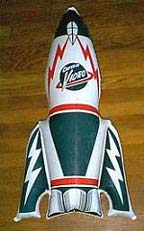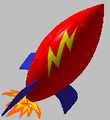
Space Cadet
Briefing: Captain Video
More Captain Video
Tom Corbett
More Tom Corbett
Space Patrol
More Space Patrol Space Hero Files
Video Sources
Books & Comics
"I Was There!"
Space Interviews
Space Reports Space Gallery
Space Album
Space Origins
Space Toy Box
Roaring Plastic
Serial Heroes The 1950s
Cosmic Feedback
Colliding Heroes
Space Stamps
Roaring Reviews Space Notice
Space Links <--Retro to
Main Page













 Space Toys
Space Toys 
If your
childhood years fell in the interval from 1947 to 1956, and you loved
rockets and space travel, you didn't have a whole lot to choose from at
the toy stores! During my entire childhood, I found only two different toy
rockets of any significant size. Thanks to Bill Hanlon's great book
PLASTIC TOYS (Shiffer, 1993), I now know that these were the X-300
Space Cruiser, 10 inches long, from Pyro Plastics (a Flash
Gordon-style ship with a transparent plastic nose) and the Rocket
Ship from Archer Plastics, a winged V2-style ship, 15 inches long,
that many comic-book artists used for reference in the 1952-5 period. To
find a crew for the space ships was even more difficult. I had figures
from two different manufacturers. Archer Plastics provided some space-suited
adventurers about 4 inches tall, with removable cylindrical helmets. Easier to find were the Premier Products spacemen,
about 3 inches tall. And that was about it!
So one of the major impacts of the Golden Age TV
space adventure programs, CAPTAIN VIDEO, SPACE CADET and SPACE PATROL, was
the wide range of space toys they provided, overwhelming alongside the
poverty of the space toy offerings of the local Kress and Woolworths
outlets. The majority of the TV-series-related toys seen by kids were
premiums offered by the sponsors of the programs. For a cereal boxtop and
25 cents, or thereabouts, kids could get some really amazing things to
play with. Such boxtop premiums had a long history beginning with radio
adventure series in the late 1920s and continuing into the late 1940s,
then transferring fairly seamlessly to television. There were also, of
course, "free premiums," cheap toys that came inside the cereal boxes
themselves.
It is worth mentioning that right around Christmas,
some of the larger retail chains offered Marx Playsets that had a
television tie-in. Particularly in 1952, there were the Space Patrol
Academy Playset and the Tom Corbett Space
Academy Playset, gigantic boxes which
contained metal-walled buildings, with loads of plastic furniture,
vehicles, weapons and dozens of posed figures. A comparable item was the
so-called Superior Space Port, which is usually referred to as the Captain Video Spaceport, since it came with spacemen, space aliens, space
vehicles and space weapons sold separately by Lido under the Captain Video
name. These big "playsets" were quite expensive, and neither I nor any
other kid I knew ever even heard of their existence, much less owned one.
Ditto for such big-ticket items as Space Patrol and Space Cadet uniforms,
and even space suits, complete with clear plastic bubble
helmets. Of course you could also get pajamas, watches and the like,
imprinted with the logo of your space hero.
In what follows I am going to emphasize the
mail-order premiums offered by the Space Hero TV shows, because these were
the most exciting and best remembered of the space-themed toys available
during 1949-55. They fuelled our dreams and provided the necessary
hardware for our play sessions, at prices we could all afford. Given a
weekly allowance of 25 or 50 cents, in fact, we kids could get along quite
well. Comic books cost 10 cents, movie matinees 15 or 25 cents, the Archer
and Premier spacemen were sold in stores for about 15 cents, and typical
mail order premiums were 25 or 50 cents, plus 2 or 3 cents postage.
CAPTAIN VIDEO, the jewel in
the crown of poverty-row network DuMont, had a poverty-row line of
premiums... but there were still many more than I knew of as a kid. There
was the Video Ranger, membership kit, photos of Captain Video and the Ranger, a nice assortment of
rings (one of which was rocket-shaped
and allowed you to "print photos" using the sun as a light source, another
of which launched flying
saucers, another of which allowed you to stamp your documents with the
CV seal), a tiny brass decoder, and a tiny Secret Ray Gun flashlight, also called a Rite-O-Lite, which could be used to write messages on a Luma-Glo card-- messages
obliterated by daylight but clearly legible in the dark! At stores you
could find a Captain Video bookbag to carry your textbooks back and forth to school. By far the greatest
premium offered by Captain Video was a space helmet, exactly like the one worn by the Captain himself.
As Don Glut says in his fine book, THE GREAT TELEVISION HEROES (Doubleday, 1975), it cost "an incredible dollar,
but it was absolutely worth it." A dome-shaped headpiece (usually red or
blue) was attached by snap-on grommets to a (usually) white plastic piece
that encircled the head, and had black earphone-like bulges on the sides.
More grommets attached a curved clear plastic visor, which could be raised
or lowered. My brother and I wore ours at every opportunity! The relatively high price meant that
many helmets remained unsold when Captain Video and the Rangers left the
air, and they then appeared in toy stores. Also in toy stores, thanks to
Lido Toys, there were sets of Captain Video spacemen, 4-inch plastic
figures of the Captain, the
Ranger, a generic Video Ranger, and the robot Tobor, plus an assortment of space aliens ("Interplanetary Space Men"). Slightly smaller versions of
these same figures also came free in every box of Post's Raisin Bran! You could even find
some tiny models of Viking
sounding rockets in the next season's Bran boxes. In stores, Lido provided
boxed sets of "supersonic space ships," assortments of "space tanks," and
many less-identifiable rolling toys. Alas, there was never a Captain Video
Ray Pistol; the Captain himself normally used a Buck Rogers Sonic Ray Blaster, 1947 model. Perhaps to make up for
that, there was the Lido atomic cannon, an inflatable vinyl flying rocket,
a Captain Video cap pistol (!), etc. One unexpectedly popular CV item was the Captain Video
Space Game from Milton-Bradley. Hundreds of thousands must have been sold and they very often show up on eBay today.
TOM CORBETT, SPACE CADET offered a
large spectrum of mail-order premiums, and more expensive toys could be
found in stores, including a camera, and garishly-lithographed metal spaceships, space rifles and pistols.
Among premiums and store offerings, there was a signal-siren flashlight,
the 2-Way Spacephone (a plastic version of the immortal tin can and string
telephone system), 3 Power Space Field
Glasses, an all-plastic cylindrical space
helmet with a one-way viewport, various belts and rings, a Space Cadet
membership kit with decoder, space
goggles and rocket balloons, a pin-on Rocket Light, magic space pictures, jigsaw puzzles, coloring books, a record,
etc. A number of items, such as the Rocket Rings, came "free at no extra cost" right in the cereal boxes of
Kellogg's PEP. On the SPACE CADET TV show bad guys used a slightly
modified version of the ubiquitous Buck Rogers Sonic Ray pistol, while the
Cadets used a nondescript soapbar-shaped paralo-ray gun (and later a
clearly recognizable soldering gun!), but kids could purchase a very
impressive-looking all-plastic Space Cadet Atomic Pistol. Generally bright red, with a relatively huge
barrel, it worked like the Sonic Ray pistol-- when the trigger was
pulled, it emitted a "sensational super 300 foot beam" of light, and
perhaps a buzz. In stores there were also sets of Space Cadet marionettes,
and the very futuristic Space Cadet atomic
rifle. It's little known today but there was also a Tom Corbett Space
Cadet board game-- the goal of play was to graduate from Space Academy,
something Tom himself never managed. Other original Space Cadet items I
have seen over the years include a watch, working "belt communicators," a paint set, a casting set allowing you to make
plaster statuettes of the five basic characters, the official camera, a "balloon spaceship" with launching cradle, a wrist
compass, and an "official belt." Apart from the plastic rings in the
PEP boxes, there were silvery metal rings available in stores and as mail
premiums. Perhaps the ultimate item was the TCSC grooming kit, complete
with official bubble bath and "hair slickum."
SPACE PATROL had by far the largest set of premiums of any of the Space Adventure TV shows. There was even a catalog of
products, issued annually. Just call to mind the Space Binoculars, the Hydrogen
Ray Gun Ring (same idea as the legendary Lone Ranger Atomic-Bomb
ring!), the Cosmic Smoke Gun, the Space Patrol Periscope, the
Space-O-Phones, the Martian Totem Head and its clone the Space Patrol Outer Space Helmet, the Space Patrol Emergency Kit, the Space Patrol
Diplomatic Pouch(!), the really nifty Space Patrol Project-O-Scope, the Decoder Buckle and Official
Belt, Cosmic Rocket Launcher, Microscope, Giant Balloon, the Rocket
Lite flashlight, more Magic Space Pictures, coloring books, jigsaw
puzzles, Space Coins, Cosmic Cap, Space Jet glider, rocket-shaped ball point
pen and rubber stamp, a Space Patrol Bank
if the kid had any coins left, and a Rocket Gun which fired darts, and was identical to the one used by Commander Corry and Cadet Happy! In stores one could find a huge
and expensive Space Patrol Outer Space Plastic Helmet identical to the
ones used by Corry and Happy on the TV show. One of the rarest Space
Patrol toys found in stores was the Monorail, an elaborate battery-powered monorail train which hung from and ran on a
satisfying amount of overhead track on plastic pylons. Equally rare is the
fabulous Space Patrol Autosonic Rifle. In stores you could also get authentic Space Patrol Boots. But
the greatest Space Patrol premium was the cardboard Rocket Cockpit. It packed flat, but folded out
into three linked panels that offered a nice selection of movable cardboard dials and metal spinners, as well as "atomic cannon that really
work" with the help of a rubber band. The cockpit controls not only permitted space travel, but allowed you to decode secret messages
and even travel in time. Another amazing cardboard item was the Lunar Fleet Base; you could cover a card table with these buildings, space ships, launchers and personnel.
SPACE PATROL was unique in
completely integrating the premium being offered in a given month to the
plot and action of the programs. If the offering was a periscope, Buzz and Happy would find use for that periscope in every show for a
while, and ditto for binoculars, code belts, Cosmic Smoke Guns, or whatever. Where the toy involved
was a totally pointless piece of crap such as a space coin, overworked
sole writer Norman Jolley really had his task cut out for him to find a
way to mention it. But he always managed. Perhaps for this reason, the
Space Patrol premiums seem to be better remembered today than any
others.
The CBS series ROD BROWN OF THE ROCKET RANGERS was a too-slavish copy
of TOM CORBETT, SPACE CADET, and never managed
to generate much of an audience or to pick up a sponsor. I have seen an advertisement for a Rod Brown Neutralizer Pistol (the program's clone of
the Space Cadet Paralo-Raygun), but do not know if it was ever manufactured. From CBS you could order a Rocket Ranger membership
card, or a "squadron
charter," and that was about it for Rod, except for a recording
of the very strangely orchestrated Rocket Rangers March and Song to be
found in stores. By contrast, despite the great handicap of being a
syndicated series with no nationwide sponsors, ROCKY
JONES, SPACE RANGER had a few premiums and toys. The most often
seen are a Space Ranger membership kit, a "wallet kit" with fake "outer space money" and a Space Ranger badge,
a coloring
book, a watch, and a record. Collectors will note that all four of
these space adventure series spun off records, and the SPACE PATROL, CAPTAIN VIDEO and ROCKY JONES records
contain brief but action-filled adventures with the original TV casts. One
now-rare giveaway item was the Rocky Jones Space Ranger Space Calculator,
a kind of round cardboard sliderule.
There was another connection between toys and the Space Adventure Heroes of the early 1950s. TV prop men found it easiest, when a ray gun was needed, to visit the local toy department routinely to provide arms for both villains and heroes. The most commonly used weapon in my experience was the Buck Rogers Sonic Ray Blaster, carried unmodified by CAPTAIN VIDEO, and seen with various attachments that disguise it slightly on SPACE PATROL and TOM CORBETT, SPACE CADET. Villains on CAPTAIN VIDEO, favored various versions of the large, beautiful, shining brass Daisy sparking Buck Rogers Atomic Disintegrator, and the large plastic Atomic Pistol also showed up very well, while members of the Space Patrol in the early days used a smoke-ring pistol. Rocky Jones and Winky used an unconvincing ray pistol custom made of wood, and I can't recall any weapons used by Rod Brown and the other Rocket Rangers. As for other available toys, I don't recall ever seeing any TV hero or villain use the boxy Remco Space Gun, or the nice Rex Mars Sparking Pistol, or the incredible Hubley Disintegrator Cap Pistol, but several space heroes, particulary Captain Video, are to be seen carrying a generic plastic space rifle. A whole collection could be formed around the theme of "unofficial weapons used in live TV space adventure series of the early 1950s."
Manufacturers were somewhat fickle: versions of the nifty Atomic Pistol-- or the useless wrist compass-- could be found bearing not only the logos of SPACE CADET and SPACE PATROL, but also Flash Gordon and Buck Rogers. There was overlap even in the mail-order premiums. For instance, the cardboard space helmet offered by SPACE CADET was also offered by SPACE PATROL, with minor variations in the printing. The Space Cadet Spacephone looked suspiciously like the Space Patrol Space-O-Phone. And so on. Alas, all toys of this type and era have survived poorly. The expensive store items sold poorly, while the inexpensive cardboard premiums came apart, were water-damaged, or suffered various indignities that caused them to be thrown away by kids or parents. If you see any of the things I have mentioned offered for sale, be prepared to pay heavily... but please consult some space-toy expert (which I am NOT!) about current fair prices before you buy.
 Space Toys
Space Toys 


